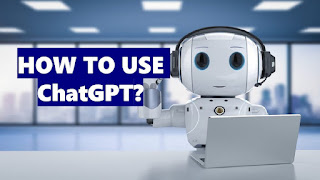How To Use ChatGPT ? Topics Related To ChatGPT
ChatGPT is a large language model developed by OpenAI. It is part of a family of models known as GPT (Generative Pre-trained Transformer) that are designed to generate human-like responses to text-based prompts.
ChatGPT has been trained on a massive corpus of text data and is capable of understanding and generating text in a wide range of domains, from news articles and scientific papers to social media posts and casual conversation. It can be used for a variety of natural language processing tasks, such as language translation, question answering, and text generation.
As an AI language model, ChatGPT can interact with users in natural language and provide intelligent responses to their queries and statements. It can be integrated into various applications, such as chatbots, virtual assistants, and customer support systems, to provide a more personalized and efficient user experience.
You can use ChatGPT to ask questions or get information on a variety of topics. Here's how to use it:
- Start by typing your question or topic into the chat box.
- ChatGPT will process your question and provide a response based on the information it has been trained on.
- If you need more information or clarification, you can ask follow-up questions and ChatGPT will provide more detailed answers.
- If you need help with a specific task, such as writing code or solving a math problem, be sure to provide as much detail as possible to help ChatGPT understand your question.
- ChatGPT is a language model, so it can understand many different types of questions and topics. However, there may be some topics that it is not familiar with or may not have enough information on, in which case it may not be able to provide a helpful response.
- Remember that ChatGPT is an AI language model and not a human expert, so the information it provides should be verified and used at your own discretion.
- Lastly, be courteous and respectful when interacting with ChatGPT, as it is designed to provide helpful responses and assist with your inquiries.
ChatGPT is a natural language processing model developed by
OpenAI. It is a variant of the GPT family of models, which are based on the
Transformer architecture and are trained using unsupervised learning
techniques.
Here are some details about ChatGPT:
Size: ChatGPT has been trained on a large corpus of text data and has billions of parameters, making it one of the largest language models in existence.
Pre-training data: ChatGPT has been pre-trained on a diverse range of text data, including books, articles, and web pages. The pre-training data includes text in multiple languages and covers a wide range of topics.
Fine-tuning: After pre-training, ChatGPT can be fine-tuned on specific tasks or domains by training it on a smaller dataset of task-specific text. This allows it to adapt to specific use cases, such as customer support or conversational agents.
Applications: ChatGPT can be used for a variety of natural language processing tasks, including language translation, text summarization, question answering, and chatbot development.
Ethics: OpenAI has implemented ethical guidelines to ensure that the use of ChatGPT and other AI technologies is responsible and does not cause harm to individuals or society as a whole.
Here are some of the most searched topics related to ChatGPT:
How does ChatGPT work? This is a common question among people who are interested in understanding the underlying architecture and mechanisms of ChatGPT.
ChatGPT vs GPT-3: As two of the largest and most advanced language models in existence, people often compare ChatGPT to GPT-3 to understand their similarities and differences.
ChatGPT applications: Many people are interested in learning about the different applications of ChatGPT, including chatbot development, customer support, and content generation
ChatGPT limitations: Despite its impressive capabilities, ChatGPT still has limitations, and people often search for information on what it cannot do.
ChatGPT training data: People may search for information on the type and size of the data that ChatGPT was trained on, as this can influence its performance and capabilities.
ChatGPT examples: People may search for examples of ChatGPT in action, such as sample conversations with chatbots or text generated by the model.
ChatGPT tutorials: There is a growing interest in learning how to work with ChatGPT, and people may search for tutorials on how to fine-tune the model for specific tasks or develop custom chatbots.
ChatGPT news: As one of the most advanced AI models, people may search for the latest news and updates on ChatGPT, including research papers and new applications.



Comments
Post a Comment